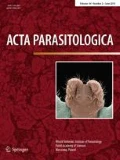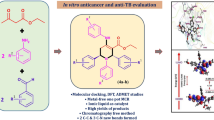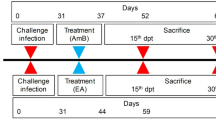Abstract
Purpose
A number of tetrahydropyrimidines and their bioisosteric dihydropyridines bearing chloro substituent at various positions of phenyl ring in C4 of main scaffolds were designed, synthesized and evaluated for antileishmanial activity.
Methods
The antileishmanial activity of the synthesized compounds was evaluated against promastigote and amastigote forms. Moreover, molecular docking studies of the compounds in pteridine reductase 1 (PTR1) pocket were carried out to describe the results of biological experiments.
Results
The compounds exhibited moderate to good antileishmanial activity against promastigote and amastigote forms. Among the screened compounds, 1d and 2c were found as the most potent compounds against promastigote form with EC50 values of 15.5 and 10.5 µM, respectively. Compounds 2a and 2c were the most potent compounds against amastigote form with EC50 values of 5.4 and 2.2 µM, respectively.
Conclusion
According to structure–activity relationship (SAR) studies, the chloro substituent in different positions of phenyl ring at C4 of 1,2,3,4-tetrahydropyrimidine (THPM) and 1,4-dihydropyridine (DHP) rings and also the length of the chain belonging to the ester groups could be important for antileishmanial activity of these compounds. Most of these compounds exhibited low cytotoxicity against macrophages. Compounds 1 h, 2a, 2b and 2c revealed higher activity than glucantime while all compounds showed lower activity toward amphotericine B. Docking studies showed that the synthesized compounds were fit well in the PTR1 pocket. Compounds 1 h and 2c indicated the highest score docking among screened compounds in PTR1 enzyme.





Similar content being viewed by others
References
Serafim VL, Felix MB, Silva DKF, Rodrigues KAF, Andrade PN, Almeid SMV, Santos SA, Oliveira JF, Lima MCA, Mendonca-Junior FJB, Scotti MT, Oliveira MR, Moura RO (2018) New thiophene-acridine compounds: Synthesis, antileishmanial activity, DNA binding, chemometric, and molecular docking studies. Chem Biol Drug Des 91:1141–1155. https://doi.org/10.1111/cbdd.13176
World Health Organization (WHO), Leishmaniasis: http://www.who.int/leishmaniasis/en/
Al-Jabi SW (2019) Arab world’s growing contribution to global leishmaniasis research (1998–2017): a bibliometric study. BMC Public Health 19:625. https://doi.org/10.1186/s12889-019-6969-9
Ortiz D, Guiguemde WA, Hammill JT, Carrillo AK, Chen Y, Connelly M, Stalheim K, Elya C, Johnson A, Min J, Shelat A, Smithson DC, Yang L, Zhu F, Guy RK, Landfear SM (2017) Discovery of novel, orally bioavailable, antileishmanial compounds using phenotypic screening. PLoS Negl Trop Dis 11:e0006157. https://doi.org/10.1371/journal.pntd.0006157
World Health Organization (WHO), https://www.who.int/news-room/fact-sheets/detail/leishmaniasis
Zabala-Peñafiel A, Todd D, Daneshvar H, Burchmore R (2020) The potential of live attenuated vaccines against Cutaneous Leishmaniasis. Exp Parasitol 210:107849. https://doi.org/10.1016/j.exppara.2020.107849
Ghorbani M, Farhoudi R (2018) Leishmaniasis in humans: drug or vaccine therapy? Drug Des Devel Ther 12:25–40. https://doi.org/10.2147/DDDT.S146521
Oliveira LFG, Souza-Silva F, Cortes LMC, Cysne-Finkelstein L, Pereira MCS, Junior FOO, Pinho RT, Real SC, Bourguignon SC, Ferreira VF, Alves CR (2018) Antileishmanial activity of 2-methoxy-4H-spiro-[naphthalene-1,2′-oxiran]-4-one (Epoxymethoxy-lawsone): a promising new drug candidate for leishmaniasis treatment. Mol 23:864. https://doi.org/10.3390/molecules23040864
Staderini M, Piquero M, Abengozar MA, Nacher-Vazquez M, Romanelli G, Lopez-Alvarado P, Rivas L, Bolognesi ML, Menendez JC (2019) Structure-activity relationships and mechanistic studies of novel mitochondria-targeted, leishmanicidal derivatives of the 4-aminostyrylquinoline scaffold. Eur J Med Chem 171:38–53. https://doi.org/10.1016/j.ejmech.2019.03.007
Bhattacharya SK, Sinha PK, Sundar S, Thakur CP, Jha TK, Pandey K, Das VR, Kumar N, Lal C, Verma N (2007) Phase 4 trial of miltefosine for the treatment of Indian visceral Leishmaniasis. J Infect Dis 196:591–598. https://doi.org/10.1086/519690
Ashok P, Chander S, Chow LMC, Wong ILK, Singh RP, Jha PN, Sankaranarayanan M (2017) Synthesis and in-vitro anti-leishmanial activity of (4-arylpiperazin-1-yl)(1-(thiophen-2-yl)-9H-pyrido[3,4-b]indol-3-yl)methanone derivatives. Bioorg Chem 70:100–106. https://doi.org/10.1016/j.bioorg.2016.11.013
Nagle AS, Khare S, Kumar AB, Supek F, Buchynskyy A, Mathison CJ, Chennamaneni NK, Pendem N, Buckner FS, Gelb MH, Molteni V (2014) Recent developments in drug discovery for leishmaniasis and human African trypanosomiasis. Chem Rev 114:11305–11347. https://doi.org/10.1021/cr500365f
Sepehri S, Sánchez HP, Fassihi A (2015) Hantzsch-Type dihydropyridines and Biginelli-type tetra-hydropyrimidines: a review of their chemotherapeutic activities. J Pharm Pharm Sci 18:1–52. https://doi.org/10.18433/j3q01v
Razzaghi-Asl N, Sepehri S, Ebadi A, Karami P, Nejatkhah N, Johari-Ahar M (2020) Insights into the current status of privileged N-heterocycles as antileishmanial agents. Mol Divers 24:525–569. https://doi.org/10.1007/s11030-019-09953-4
Kumar P, Kumar A, Verma SS, Dwivedi N, Singh N, Siddiqi MI, Tripathi RP, Dube A, Singh N (2008) Leishmania donovani pteridine reductase 1: biochemical properties and structure-modeling studies. Exp Parasitol 120:73–79. https://doi.org/10.1016/j.exppara.2008.05.005
Kaur J, Sundar S, Singh N (2010) Molecular docking, structure-activity relationship and biological evaluation of the anticancer drug monastrol as a pteridine reductase inhibitor in a clinical isolate of Leishmania donovani. J Antimicrob Chemother 65:1742–1748. https://doi.org/10.1093/jac/dkq189
Saudi MNS, El-Semary MMA, Elbaya RY, Jaed MI, Eiss MM, Amer EI, Baddour NM (2012) Synthesis and biological evaluation of a novel class as antileishmanial agent. Med Chem Res 21:257–267. https://doi.org/10.1007/s00044-010-9532-x
Rashid U, Sultana R, Shaheen N, Hassan SF, Yaqoob F, Ahmad MJ, Iftikhar F, Sultana N, Asghar S, Yasinzai M, Ansari FL, Qureshi NA (2016) Structure based medicinal chemistry-driven strategy to design substituted dihydropyrimidines as potential antileishmanial agents. Eur J Med Chem 115:230–244. https://doi.org/10.1016/j.ejmech.2016.03.022
Corona P, Gibellini F, Cavalli A, Saxena P, Carta A, Loriga M, Luciani R, Paglietti G, Guerrieri D, Nerini E, Gupta S, Hannaert V, Michels PAM, Ferrari S, Costi PM (2012) Structure-based selectivity optimization of piperidine-pteridine derivatives as potent Leishmania pteridine reductase inhibitors. J Med Chem 55:8318–8329. https://doi.org/10.1021/jm300563f
Zarrabi Z, Saghaie L, Fassihi A, Pestechian N, Saberi S (2020) Synthesis and comparison of anti-Leishmania major activity of antimony and iron complexes of 3-hydroxypyran-4-one and 3-hydroxypyridine-4-one as bi-dentate ligands. J Rep Pharma Sci 9:177–182. https://doi.org/10.4103/jrptps.JRPTPS_64_18
Hendrickx S, Leemans A, Mondelaers A, Rijal S, Khanal B, Dujardin JC, Delputte P, Cos P, Maes L (2015) Comparative fitness of a parent leishmania donovani clinical isolate and its experimentally derived paromomycin resistant strain. PLoS ONE 10:e0140139. https://doi.org/10.1371/journal.pone.0140139
Silva IA, Morato CI, Quixabeira VBL, Pereira LIA, Dorta ML, Oliveira MAP, Horta MF, Ribeiro-Dias F (2015) In vitro metacyclogenesis of leishmania (Viannia) braziliensis and leishmania (Leishmania) amazonensis clinical field isolates, as evaluated by morphology, complement resistance, and infectivity to human macrophages. Biomed Res Int 2015:393049. https://doi.org/10.1155/2015/393049
Varshosaz J, Arbabi B, Pestehchian N, Saberi S, Delavari M (2018) Chitosan-titanium dioxide-glucantime nanoassemblies effects on promastigote and amastigote of Leishmania major. Int J Biol Macromol 107:212–221. https://doi.org/10.1016/j.ijbiomac.2017.08.177
Kaur J, Dube D, Ramachandran R, Singh P, Singh N (2012) Thianthrene is a novel inhibitor of Leishmania donovani pteridine reductase 1 (PTR1). J Mol Biochem 1:68
Dutta A, Bandyopadhyay S, Mandal C, Chatterjee M (2005) Development of a modified MTT assay for screening antimonial resistant field isolates of Indian visceral leishmaniasis. Parasitol Int 54:119–122. https://doi.org/10.1016/j.parint.2005.01.001
Badirzadeh A, Heidari-Kharaji M, Fallah-Omrani V, Dabiri H, Araghi A, Chirani AS (2020) Antileishmanial activity of Urtica dioica extract against zoonotic cutaneous leishmaniasis. PLoS ONE 14:e0007843. https://doi.org/10.1371/journal.pntd.0007843
Sepehri S, Saghaie L, Fassihi A (2017) AntiHIV-1 activity prediction of novel gp41 inhibitors using structure-based virtual screening and molecular dynamics simulation. Mol Inform 36:1600060. https://doi.org/10.1002/minf.201600060
Spinks D, Ong HB, Mpamhanga CP, Shanks EJ, Robinson DA, Collie IT, Read KD, Frearson JA, Wyatt PG, Brenk R, Fairlamb AH, Gilbert IH (2010) Design, synthesis and biological evaluation of novel inhibitors of Trypanosoma brucei pteridine reductase 1. Chem Med Chem 6:302–308. https://doi.org/10.1002/cmdc.201000450
Kaur J, Dutta S, Chang KP, Singh N (2013) A member of the Ras oncogene family, RAP1A, mediates antileishmanial activity of monastrol. J Antimicrob Chemother 68:1071–1080. https://doi.org/10.1093/jac/dks507
Tulloch LB, Martini VP, Iulek J, Huggan JK, Lee JH, Gibson CL, Smith TK, Suckling CJ, Hunter WN (2010) Structure-based design of pteridine reductase inhibitors targeting African sleeping sickness and the leishmaniases. J Med Chem 53:221–229. https://doi.org/10.1021/jm901059x
Bakherad Z, Safavi M, Fassihi A, Sadeghi-Aliabadi H, Bakherad M, Rastegar H, Ghasemi JB, Sepehri S, Saghaie L, Mahdavi M (2019) Preparation of some novel imidazopyridine derivatives of indole as anticancer agents: one-pot multicomponent synthesis, biological evaluation and docking studies. Res Chem Intermed 45:2827. https://doi.org/10.1007/s11164-019-03915-z
Caroli A, Ballante F, Wickersham RB, Corelli F, Ragno R (2014) Hsp90 inhibitors, part 2: ccombining ligand-based and structure-based approaches for virtual screening application. J Chem Inf Model 54:970–977. https://doi.org/10.1021/ci400760a
Cunningham ML, Beverley SM (2001) Pteridine salvage throughout the Leishmania infectious cycle: implications for antifolate chemotherapy. Mol Biochem Parasitol 113:199. https://doi.org/10.1016/s0166-6851(01)00213-4
Acknowledgements
This work was supported by the Ardabil University of Medical Sciences under Grant IR.ARUMS.REC.1397.292.
Author information
Authors and Affiliations
Corresponding author
Ethics declarations
Conflict of interest
The authors declare no conflicts of interest.
Additional information
Publisher's Note
Springer Nature remains neutral with regard to jurisdictional claims in published maps and institutional affiliations.
Supplementary Information
Below is the link to the electronic supplementary material.
Rights and permissions
About this article
Cite this article
Jeddi, B., Saberi, S., Menéndez, J.C. et al. Synthesis and Biological Evaluation of Tetrahydropyrimidine and Dihydropyridine Derivatives Against Leishmania Major. Acta Parasit. 67, 255–266 (2022). https://doi.org/10.1007/s11686-021-00457-6
Received:
Accepted:
Published:
Issue Date:
DOI: https://doi.org/10.1007/s11686-021-00457-6




